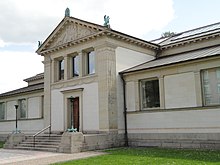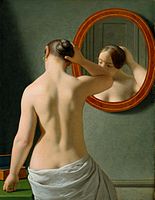Hirschsprung Collection
The Hirschsprung Collection ( Danish Den Hirschsprungske Samling ) is a museum for fine arts in Denmark and is located in the center of the capital Copenhagen at Stockholmsgade 20. It is located in the Østre Anlæg park near the Statens Museum for Kunst and is part of the also called Park Museum area. It was built to house Heinrich Hirschsprung 's private art collection and houses a collection of Danish art from the 19th and early 20th centuries.

The collector
Heinrich Hirschsprung (1836–1908) came from a family with Jewish-German roots. In 1858 Heinrich and his brother Bernhard (1834–1909) took over the management of the tobacco trade founded by their father in 1926 and expanded it to AM Hirschsprung & Sønner , specializing in the production of cigars. Hirschsprung was married from 1864 to Pauline Elisabeth Jacobson (1845–1912), who also came from a Jewish family.
Hirschsprung started his art collection in 1866 with the purchase of a painting by Julius Exner : Lille pige, der lader en gammel mand lugte til en blomst (Little girl who lets an old man smell a flower). Numerous acquisitions resulted in an extensive collection in which all well-known Danish artists of the Golden Age , the Skagen painters and the symbolists were represented.
While the collection was on view in an exhibition at Charlottenborg Palace in 1902 , Hirschsprung felt it was time to make the negotiations with the Danish Ministry of Culture and the City of Copenhagen about a foundation public that had been ongoing since 1900 . At that time, the collection already comprised 1,980 items, including around 500 oil paintings, a large number of watercolors and drawings, and around 200 sculptures.
"Mr. Rentier Heinrich Hirschsprung will transfer his extremely rich collection of paintings to the state by only imposing the condition that a suitable museum building be set up for it." These conditions corresponded roughly to those of the Ny Carlsberg Glyptotek Foundation . The demands for an independent building led to a long-term political and art-political debate. It was not until 1907 that the conditions were accepted and construction of the museum could begin. Heinrich Hirschsprung did not live to see the opening, which took place in the presence of his widow on July 8, 1911.
The building
The property provided by the city was within sight of the Statens Museum for Kunst in the Østre Anlæg park , part of the former fortifications of Copenhagen . The museum building was built from 1908 to 1911 in the classicism style by the Danish architect Hermann Baagøe Storck (1839–1922) and is listed as one of his main works. The central part of the main facade appears in the manner of a classical temple gable with Doric pilasters . The triangular gable relief comes from the sculptor Kai Nielsen (1882–1924). The outer walls were clad with marble, while the roof is covered with copper.
The symmetrical floor plan consists of four large skylight galleries surrounded by smaller galleries with floor-to-ceiling windows. In the entrance hall of the museum there is a floor mosaic, made in 1910 by Joakim Skovgaard (1856–1933), the son of the painter PC Skovgaard . The mosaic contains stylized tobacco plants to commemorate the museum's founder and his profession.
The interior design, the furnishing, cataloging and hanging of the paintings was the responsibility of the art historian Emil Hannover (1864–1923), who was the first director of the museum until his death.
The collection
Emil Hannover had been responsible for cataloging the collection since 1902. According to Hirschsprung and Hanover, the now very broad collection should also serve as a documentation center for Danish art of the 19th century. In the spirit of Hirschsprung, Hanover commissioned the hanging in chronological order. Separate rooms were dedicated to the painters, which were additionally furnished with furniture that originally belonged to the artists. This gave the impression that one was visiting the home of a great private art lover.
Golden age
The period from 1800 to 1850, which is considered to be the epoch of high cultural prosperity, is referred to as the Golden Age of Denmark ( Danish Den Danske Guldalder ). This era is represented by artists such as Christoffer Wilhelm Eckersberg , Christen Købke , Wilhelm Bendz , Wilhelm Marstrand , Martinus Rørbye , PC Skovgaard and Johan Thomas Lundbye and other lesser known names.
The modern breakthrough
The modern breakthrough ( Danish Det Moderne Gennembrud ) is the common name of the strong movement of naturalism and discussion literature of Scandinavia, which replaced Romanticism towards the end of the 19th century. The term is used in the period from 1870–1890 in the history of literature in Scandinavia, which had a breakthrough from the rest of Europe during this period. The most important representative was the Danish literary critic, philosopher and writer Georg Brandes .
In painting, this breakthrough found its representatives in the Symbolists and the Skagen painters . This time will u. a. represented by works by Erik Henningsen , Lauritz Andersen Ring , Ejnar Nielsen, Joakim Skovgaard, Harald Slott-Møller, Anna Ancher , Michael Ancher , PS Krøyer , Laurits Tuxen , Kristian Zahrtmann , Vilhelm Hammershøi and Theodor Philipsen .
In addition to paintings, sculptures, drawings and sketchbooks, the museum also houses a large collection of furniture and personal effects by Danish artists and a collection of letters, including the correspondence between Krøyer and Hammershøi and Pauline Hirschsprung.
The database of the Kunstindeks Danmark & Weilbachs Kunstnerleksikon lists 921 paintings from the museum, representing 128 artists.
gallery
Christen Købke : Portrait of the painter Frederik Sødring , 1832
CW Eckersberg :
Morning toilet , 1841Kristian Zahrtmann : Leonora Christina in captivity , 1875
Michael Ancher :
Figures in the Landscape , 1880Anna Ancher :
Girls in the Kitchen , 1886Vilhelm Hammershøi : Interior with a young man reading , 1898
PS Krøyer : Summer evening on the beach in Skagen. The artist and his wife. 1899
literature
- Heinrich Hirschsprung . In: Svend Cedergreen Bech , Svend Dahl (eds.): Dansk biografisk leksikon . Founded by Carl Frederik Bricka , continued by Povl Engelstoft. 3. Edition. tape 6 : Harald – Høedt . Gyldendal, Copenhagen 1980, ISBN 87-01-77412-3 (Danish, biografiskleksikon.lex.dk ).
- Hirschsprung, Heinrich . In: Theodor Westrin (Ed.): Nordisk familjebok konversationslexikon och realencyklopedi . 2nd Edition. tape 11 : Harrisburg – Hypereides . Nordisk familjeboks förlag, Stockholm 1909, Sp. 751 (Swedish, runeberg.org ).
Web links
- Swantje Seberg: Denmark's departure into the modern age: The Hirschsprung Collection from Eckersberg to Hammershøi. In: Art and Film. Kunsthalle Hamburg, November 28, 2013, accessed on January 25, 2017 (with a video, 5:23 min).
- Den Hirschsprungske Samling , website
- Parkmuseerne joint website of Davids Samling, Den Hirschsprungske Samling, Arbejdermuseet, Rosenborg Slot, Statens Museum for Kunst (SMK) and Statens Naturhistoriske Museum
- The Hirschsprung Collection. at Visit Copenhagen.com
Individual evidence
- ↑ Park museums
- ↑ a b c Den Hirschsprungske Samling - Hirschsprung History ( Memento from January 25, 2017 in the Internet Archive )
- ↑ Hirschsprung, Heinrich . In: Theodor Westrin (Ed.): Nordisk familjebok konversationslexikon och realencyklopedi . 2nd Edition. tape 11 : Harrisburg – Hypereides . Nordisk familjeboks förlag, Stockholm 1909, Sp. 751 (Swedish, runeberg.org ).
- ^ Sigurd Müller : Collections and exhibitions. In: Kunstchronik: Weekly for art and applied arts. New series 14, issue 5, Nov. 6, 1902, p. 81 ( uni-heidelberg.de ).
- ↑ a b Den Hirschsprungske Samling, Stockholmsgade. Selskabet for København's history. ( Memento from October 6, 2015 in the Internet Archive )
- ↑ Further articles can be found on Wikidata under Modern Breakthrough .
- ↑ Det Moderne Gennembrud - Modern Breakthrough. In: Encyclopædia Britannica online.
- ↑ Artworks in Den Hirschsprungske Samling. In: Kunstindeks Danmark / Weilbachs Kunstnerleksikon (Danish).
- ^ Artists represented in Den Hirschsprungske Samling. In: Kunstindeks Danmark / Weilbachs Kunstnerleksikon (Danish).
- ↑ Samling - Den Hirschsprungske Samling hirschsprung.dk.
- ↑ In the Danish-language Wikipedia under the title Værker i Den Hirschsprungske Samling you can find a predominantly illustrated list of the museum's works
Coordinates: 55 ° 41 ′ 23.6 " N , 12 ° 34 ′ 38" E










